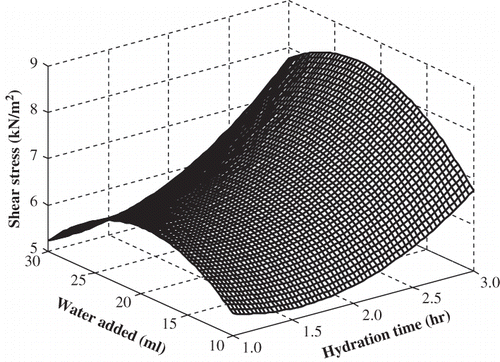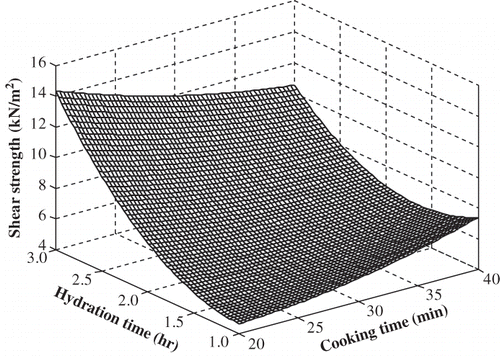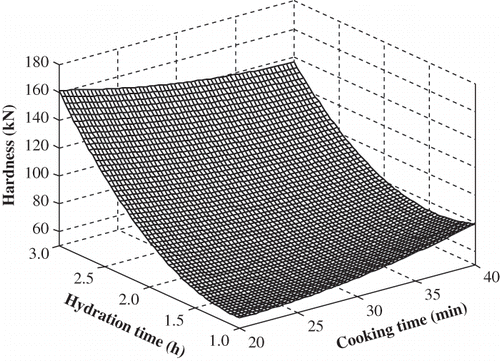Abstract
Optimisation of fura production using response surface methodology was studied. The quadratic polynomial regression model was adequate and acceptable at 0.05% level for predicting shear stress (SHS), shear strength (SHT), and hardness of fura (HOF)). The importance of process variables (cooking time (CKT), flour hydration time (FHT) and water added (WAD)) on texture of fura is in the order; FHT (X2) > WAD (X3) > CKT (X1). The FHT and WAD were the most important factors affecting the textural properties of fura. The optimal SHS (6.1 kN/m2) was obtained with FHT (1.36 hr), CKT (34.3 min) and WAD (21 ml). The optimal SHT (4.6 kN/m2) was obtained with FHT (1.1 hr), CKT (18.9 min) and WAD (25 ml). The optimal HOF (57.7 kN) was obtained with FHT (53.4 min), CKT (17.4 min) and WAD (21.8 ml). The shape of the predicted responses was saddle, i.e., a maximum or minimum response was found at various combinations of the independent variables.
INTRODUCTION
Fura is produced mainly from moist pearl millet flour, blended with spices, compressed into balls, and boiled for 30 min. While still hot, the cooked dough is worked in the mortar with pestle (with addition of hot water) until a smooth, slightly elastic cohesive lump (fura) is formed. The fura dough is rolled into 25–30 g balls by hand and dusted with raw flour. The fura is made into porridge by crumbling the fura balls into fermented whole milk (kindirimo) or fermented skimmed milk (nono).[Citation1,Citation2]
Fura is produced at home both for family and commercial consumption. The producers of fura still use the traditional method of mortar and pestle both to dehull the grain and to reduce the dehulled grain into flour.[Citation3] The major criticism of the mechanical process is that dry grain must always be used, producing flour that is too dry and when used to produce fura, does not result in the same taste as the fura from traditionally processed flour. However, Jideani[Citation4] had reported an improved fura production process using the mechanically produced flour.
The variables identified that could affect the texture of fura during processing are the water for hydrating the dry flour, cooking time and water added during pounding of the cooked flour.[Citation5] There was no specific standard developed for measuring the quality of fura. It is deemed fit and important to standardise the process of producing fura to obtain the optimum product in terms of quality, chewing ability, stability, coherency, etc. Thus, optimizing the processing of fura is of interest before food manufacturers can think of large-scale production.[Citation3] Since fura is eaten by chewing between the molars, the textural parameters are particularly important.[Citation2] Texture can be regarded as a manifestation of the rheological properties of a food. It is an important attribute since it affects processing and handling, influences food habits, and affects shelf life and consumer acceptance of foods.[Citation2]
Response surface methodology (RSM) is a collection of mathematical and statistical techniques useful for analysing problems involving several independent variables or responses and their interactions.[Citation6] Mathematical models fitted to data using least square techniques and the adequacy of models can be checked by analysis of variance. The composite rotatable design (CCRD) of Box and Hunter[Citation7] has the advantage to predict responses based on few sets of experimental data in which all factors are varied within a chosen range. The objective of this study was to determine the effects of hydration time of flour, cooking time, and water added during pounding on textural properties of fura using RSM and CCRD. Optimum conditions of independent variables were also determined.
MATERIALS AND METHODS
Source of Samples
The millet grain (Pennisetum glaucum), cloves (Eugenia caryophyllata) and ginger (Zingiber officinale) were purchased from Yelwa market in Bauchi, Bauchi State, Nigeria.
Grain Milling
Millet grains (Pennisetum glaucum) were cleaned and decorticated with dehulling machine, Amuda superfine Huller No 12031. The dehulled grains were washed and dried in a cabinet dryer, APV Mitchell Dryer No 5213/82 at 100°C for 30 min. The grains were milled into flour and sieved using 425 μm mesh sieve. The flour obtained was packed in a polyethylene bag and stored in a dry environment until required.
Spice Milling
The spice cloves (Eugenia caryophyllata) and ginger (Zingiber officinale) were cleaned, washed and dried at 100°C for an hour. The dried spices were milled into powder and sieved to obtain fine powder using 425 m mesh sieve. The powdered spices were packed into a polyethylene bag and stored in a dry environment until required.
Experimental Design and Data Analysis for Optimization
A three factor central composite and rotatable design (CCRD)[Citation7] was employed to study three responses, shear stress (Y1), shear strength (Y2), and Hardness (Y3) of fura. The cooking time (X1), flour hydration time (X2) and water added during pounding of fura (X3) were the independent variables selected to optimise Y1, Y2, and Y3 ( and ). Triplicate measurements were carried out on all design points except the centre point (0, 0, 0). Experiments were carried out in randomized order. A quadratic polynomial regression model was assumed for predicting individual Y responses. The model proposed for each response of Y was:
Table 1 Independent variables and levels used for central composite rotatable design.Footnote 1
Table 2 Central composite rotatable design arrangement and responses
Preparation of Fura
The improved fura production process described by Jideani[Citation4] was adopted in producing fura. The detail of the production process is shown in . Millet flour (100 g), 2 g ginger and 0.5 g cloves were mixed. The mixture was moistened with 67 ml of water and allowed to stand for various periods of time (). The moistened millet flour was compressed between the palms, and dropped into boiling water. The compressed flour was cooked for different times (). The cooked millet flour was pounded to cohesive dough while still hot. Varying amount of hot water was added () while pounding. The fura produced were tested for shear strength, hardness (peak force) and breaking stress.
Figure 1 Improved fura production process.[Citation4]
![Figure 1 Improved fura production process.[Citation4]](/cms/asset/194c523a-3458-411d-a610-6274f4c6dca7/ljfp_a_333316_o_f0001g.gif)
Instrumental Textural Measurement of Fura
The shear stress of fura was determined using the shear box carriage.[Citation8] Fura sample (60 mm cube) was placed in a standard 60 mm square shear box and sheared using 1, 2, and 3 kg load. At regular intervals (0.1 mm) of the displacement dial reading, the load dial reading and the vertical movement dial were recorded. Shearing was continued until the maximum stress or ‘peak’ point has been clearly defined, i.e., until at least four consecutive reading indicate a decrease in load. Each design point was determined in triplicate. The method of Head[Citation8] was used to calculate the shear stress (KN/m2). The shear stress was plotted against horizontal and vertical displacement (mm). All the curves from a triplicate set were plotted on the same graph. From the graph, the maximum shear stress was read for each sample given shear stress at failure (KN/m2).
The hardness of fura (kN) and strength of fura were determined by performing compression tests as described by Jideani[Citation2] on cylindrical samples of fura (75 mm height, 38.9 mm diameter) on the ELE International Tritest 10 (107 kN load frame) at uniaxial unconfined compression mode. The samples were uniaxially compressed until complete breakdown under a 38.9-mm diameter stainless steel plate at a constant deformation rate of 1.5-mm/min. The load ring reading was noted for each strain applied. The method of Head[Citation8] was used to calculate the strain and stress. A plot of stress against strain was obtained. From the stress-strain curves, the strength of fura was calculated in terms of breaking stress (maximum stress at failure, force per unit area). From the force-strain curve, the hardness of fura was calculated as the maximum force of the force-deformation curve. Each determination was in triplicate.
RESULTS AND DISCUSSION
Fitting the Models
Experimental values obtained for responses Y1, Y2, and Y3 for the design points are shown in . The effects of treatment variables as linear, quadratic or interaction coefficients on response variables (shear stress, shear strength, and hardness) were tested for adequacy and fitness by analysis of variance. The models represented by EquationEq. (1) for shear stress (F = 0.864; p > 0.05), shear strength (F = 5.07; p > 0.05) and hardness (F = 5.08; p > 0.05) showed that lack of fit was not significant. The model was adequate and acceptable at the 0.05% level for response variables.
Optimum Conditions for Fura Production
The regression coefficients of the three models are shown in . The coefficient of linear effect of hydration time (X2) and water added (X3) significantly affected shear strength and hardness. The coefficient of quadratic effect of hydration time (X2) significantly affected the shear strength and hardness. The coefficient of interaction effect of cooking time (X1) and hydration time (X2) significantly affected the shear strength and hardness. Using the coefficients determined (), the predicted models for shear stress (Ŷ1), shear strength (Ŷ2) and hardness (Ŷ3) were:
Table 3 Regression coefficient of predicted quadratic polynomial model for the three response variables
The three models indicated that hydration time (X2) had the most linear effect on the shear stress, shear strength, and hardness of fura as it showed the largest positive linear coefficient (). The importance of process variables for shear stress could be ranked in the following order: hydration time (X2) > water added (X3) > cooking time (X1). For shear strength and hardness, the effect of the process variables could be ranked in the following order: hydration time (X2) > cooking time (X1) > water added (X2). Results indicated that hydration time and water added were the most important factors affecting the shear stress, while hydration time (X2) and cooking time (X1) affected shear strength and hardness of fura. Pearl millet carbohydrate (almost exclusively of starch) usually makes up about 70% of the dry grain. The starch is composed of about 67% amylopectin (the insoluble component that forms a paste in water at room temperature) and 33% amylose (the soluble component that forms a gel in aqueous solution).[Citation9] It is known that when starch granule is heated up to the gelatinisation temperature in excess water, heat transfer and moisture transfer phenomena occur resulting in the swelling of the granule to several times its initial size. The swelling is the result of the loss of the crystalline order and the absorption of water inside the granular structure.[Citation10] The compressed millet flour was boiled at 100°C for varying cooking times. It was observed that the internal colour of the compressed flour balls remained white after the cooking periods. Perhaps the internal temperature did not reach gelatinisation temperature (61.1–68.7°C for pearl millet[Citation11]). The added hot water during pounding perhaps gelatinised the starch. This suggests that during the processing of fura, the millet flour (starch) would have undergone hydrothermal treatment- annealing and heat moisture treatment. Annealing is the treatment of starch in excess water at temperatures below the gelatinisation temperature. Heat moisture treatment is the treatment at relatively lower moisture and higher temperature conditions.[Citation12] The hydrothermal conditions resulted in physicochemical changes that contributed to the texture of fura. When the compressed flour was heated up to the gelatinisation temperature, heat transfer and moisture transfer phenomena occurred. The starch granules swelled, the amylase inside the granules leached out. The swollen starch granules formed a closed packed gel structure, which possessed high shear resistance.[Citation10] This is evident in the increasing effect of hydration and cooking time on the shear strength and hardness of fura. The linear and quadratic effects of the three variables were the primary determining factors of the responses for shear strength and hardness ().
to details the relationship between the independent and dependent variables as three-dimensional representation of the response surfaces. Increasing the water added and the hydration time of the flour gave a quadratic increase in shear stress. Increasing the hydration and cooking time increased the shear strength and hardness of fura. Canonical analysis was performed on the predicted quadratic polynomial model to examine the overall shape of the responses and to characterize the nature of the stationary points. The canonical forms of the equations demonstrating the nature of the responses are:
Figure 2 Response surface for the effects of flour hydration time and water added during pounding on the shear stress of fura.

Figure 3 Response surface for the effects of flour hydration time and water added during pounding on the shear strength of fura.

Figure 4 Response surface for the effects of flour hydration time and water added during pounding on the hardness of fura.

The large value of V2 for shear stress indicates of rapid changes in the responses along the hydration time (X2) axis. For shear strength and hardness the large values of V1 in each case is indicated that the quadratic effect of response surface was very sensitive to changes in cooking time (X1). All eigenvalues obtained for the analysis were of opposite signs, thus indicating that the response surface is saddle shaped where a maximum or minimum Ŷo is found at various combinations of the independent variables.
CONCLUSIONS
The quadratic polynomial regression model was adequate and acceptable at 0.05% level for predicting the individual Y responses (shear stress, shear strength and hardness of fura). The optimal shear stress of fura (6.1 kN/m2) can be obtained with a flour hydration time of 1.36 h, cooking time of 34.3 min and water addition of 21 ml during pounding. The optimal shear strength of fura (4.6 kN/m2) can be obtained with a flour hydration time of 1.1 h, cooking time of 18.9 min and water addition of 25 ml during pounding. The optimal hardness of fura (57.7 kN) can be obtained with a flour hydration time of 53.4 min, cooking time of 17.4 min and water addition of 21.8 ml during pounding.
REFERENCES
- Jideani , V.A. and Danladi , L.M. 2004 . Instrumental and sensory textural properties of fura made from different cereal grains . Int. J. Food Prop. , 8 ( 1 ) : 49 – 59 .
- Jideani , V.A.. 2002 . Instrumental and sensory textural properties of fura . Int. J. Food Prop. , 5 : 367 – 377 .
- Jideani , V.A , Nkama , I. and Agbo , E.B. 2001 . Survey of fura productions in some Northern States of Nigeria. Plant Foods for Human Nutrition . 56 : 23 – 26 .
- Jideani , V.A. 2005 . Characteristics of local pearl millet (Pennisetum glaucum) grains for fura production . Nigerian Food Journal , 23 : 193 – 204 .
- Jideani , V.A. Investigation into the storage life and packaging of fura - A Nigerian cooked millet dough , Bauchi, Nigeria : Ph.D. Thesis, 2001, Biological Sciences Programme, Abubakar Tafawa Balewa University .
- Wanasundara , P.K.J.P.D. and Shahidi , F. 1996 . Optimization of hexametaphosphate-assisted extraction of flaxseed proteins using response surface methodology . J. F. Sci. , 61 ( 3 ) : 604 – 607 .
- Box , G.E.P. and Hunter , J.S. 1957 . Multifactor experimental design for exploring response surfaces . Annals Math. Stat. , 28 : 195 – 242 .
- Head , H. H. 1995 . Manual of Soil Laboratory Testing: Soil classification and compaction test , Vol. 1 , 235 – 336 . London : Pentch Press .
- Lost Crops of Africa: Volume 1: Grains http://book.nap.edu/openbook.php?record_id=2305&page=85 (Accessed: 7 January 2008 ).
- Lii , C.-Y. , Tsai , M.-L. and Tseng , K.-H. 1996 . Effect of amylase content on reheological property of rice starch . Cereal Chemistry , 73 ( 4 ) : 415 – 420 .
- FAO Corporate Document Respository. Carbohydrate in Sorghum and Millets. Available at http://www.fao.org/docrep/t0818e/T0818E0c.htm (Accessed: 7 January 2008 ).
- Shih , F. , King , J. , Daigle , K. , An , H.-J. and Ali , R. 2007 . Physicochemical properties of rice starch modified by hydrothermal treatments . Cereal Chemistry , 84 ( 5 ) : 527 – 531 .
- Cornell , J.A.. 1992 . How to apply response surface methodology. ASQC Basic references in quality control , Milwaukee, WI : ASQC .
- Gacula , M.C. Jr. and Singh , J. 1984 . Statistical methods in food and consumer research , 214 – 268 . London : Academic Press Inc .